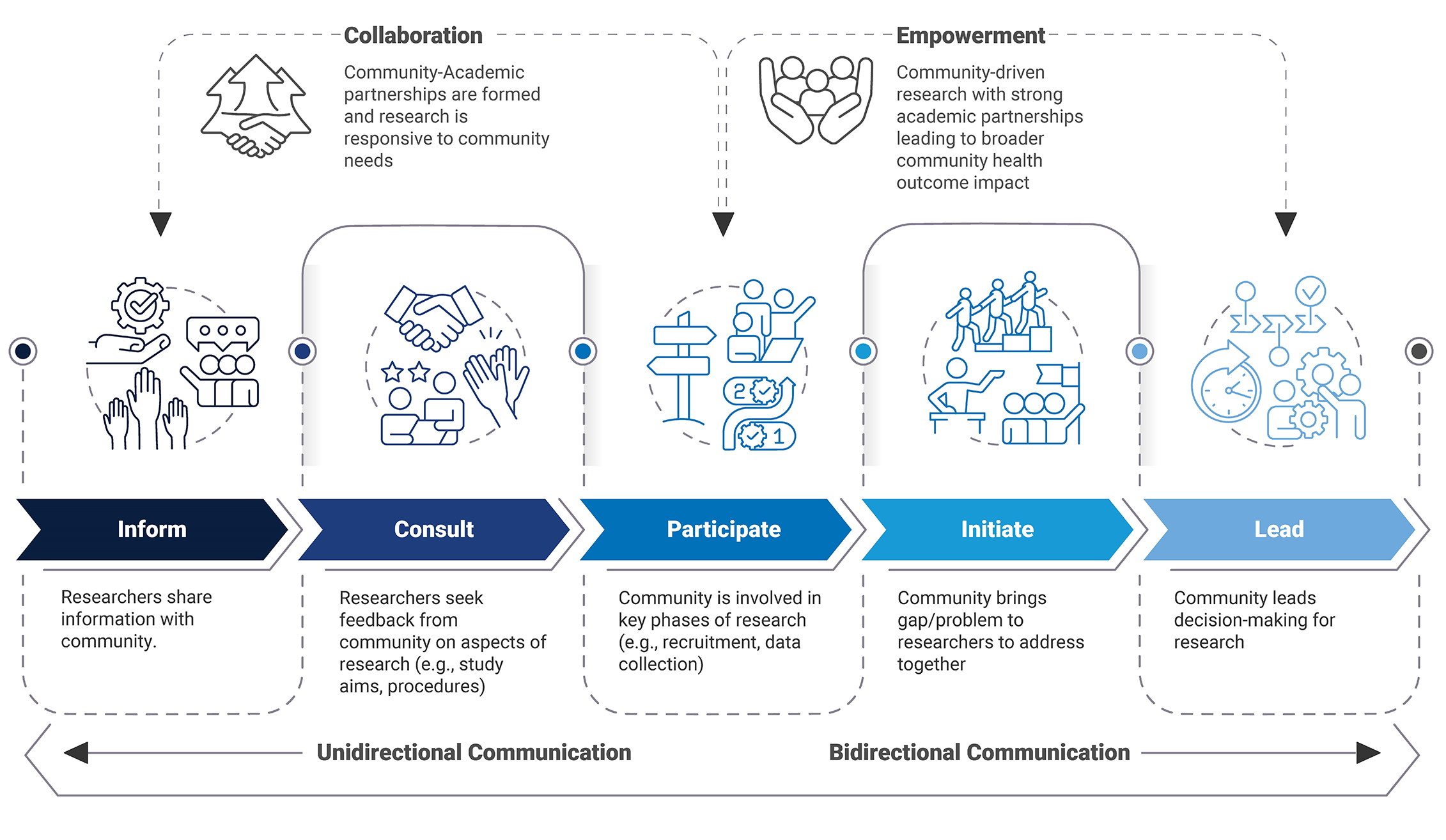Jump to topic
Search
Definition
 According to the Centers for Disease Control and Prevention (CDC), community-engaged research (CEnR) is, “the process of working collaboratively with and through groups of people affiliated by geographic proximity, special interest, or similar situations to address issues affecting the well-being of those people.”1-3 Through CEnR efforts, research and education teams can connect with community partners to prioritize, conduct and share research to improve lives and reduce health disparities.4,5 CEnR can be utilized to learn about a wide range of health concerns in varied populations. Asking research questions with the input of the community leads to the greatest application of research results, often achieving the overall goal of increased population wellness, reduced health disparities and improved health care access and delivery.5-8 In the context of CEnR, community may be an individual or a group of people. It may represent an individual or group’s geographic location, race or ethnicity, social and/or political views, occupation, virtual connectedness, physical condition, behaviors, among other characteristics.2,9-10
According to the Centers for Disease Control and Prevention (CDC), community-engaged research (CEnR) is, “the process of working collaboratively with and through groups of people affiliated by geographic proximity, special interest, or similar situations to address issues affecting the well-being of those people.”1-3 Through CEnR efforts, research and education teams can connect with community partners to prioritize, conduct and share research to improve lives and reduce health disparities.4,5 CEnR can be utilized to learn about a wide range of health concerns in varied populations. Asking research questions with the input of the community leads to the greatest application of research results, often achieving the overall goal of increased population wellness, reduced health disparities and improved health care access and delivery.5-8 In the context of CEnR, community may be an individual or a group of people. It may represent an individual or group’s geographic location, race or ethnicity, social and/or political views, occupation, virtual connectedness, physical condition, behaviors, among other characteristics.2,9-10
The Penn State CHEER program views community partnership as the foundation for improving wellness and reducing health disparities in Pennsylvania communities. By building on and connecting ongoing efforts toward novel interdisciplinary and inter-professional collaborations and efficient use of shared resources, CHEER supports CEnR projects of varying topics, sizes and scopes. Research and education teams who work with the experts at CHEER can expect to receive support in education, training and other project management services to assist in the planning, implementation and evaluation of their CEnR projects.
Members of a CEnR team

It takes a village! For CEnR to be most effective, a network of individuals works in partnership toward the same goals and objectives. As the research takes shape, the groups listed below may be modified over time. Primary groups driving the direction of the research include:
- Principal investigator (PI): Lead researcher for a study; assumes full responsibility for study.
- Co-investigator(s): A researcher who contributes significantly to a study.
- Project manager(s): A research team member who manages a research study and oversees research staff.
- Project coordinator/human research technologist(s): A research team member who coordinates day-to-day study operations.
Insider Tip
If funding allows, it can be extremely helpful to dedicate an engagement coordinator, even if part-time, to facilitate and execute the engagement process and be a key point of contact for community partners. This could be a seasoned research project manager on your team who the CHEER team can train to help them shine in their role as community liaison!
Community partners – Individuals (such as patients, caregivers, clinicians, policy makers, community health workers, educators and other community members) or organizations (such as community-based organizations, clinics, health departments, advocacy groups, agencies and other groups representing communities) who share their voices, perspectives and knowledge to inform research. “Stakeholder” is another term to describe these individuals or groups.9,13
Insider Tip
Community Health Workers (CHW) can be invaluable assets to your research team. A CHW is a frontline public health worker who is a trusted member of and/or has an intimate understanding of the community served.14 This trusting relationship enables the CHW to serve as a liaison between health and social services and the community, to facilitate access to services and improve the quality and cultural competence of service delivery, making them well positioned to assist in CEnR.15,16 Check out how the Penn State Racial and Ethnic Approaches to Community Health (REACH) Project partners with CHWs to best serve Hispanic and Latino populations in Pennsylvania communities during the COVID-19 pandemic.
- Internal main research team may include:
- Principal investigator
- Co-investigators
- Trainees (undergraduates, graduates, post-docs)
- Research project manager
- Research project coordinator/technician
- Community engagement coordinator
- Internal ancillary research team may include:
- Pre-award specialist
- Financial analyst
- IRB analyst
- Marketing specialist
- Nurse coordinator
- Data manager
- Biostatistician
- External community partner team may include:
- Advocate
- Clinic, hospital, health system representative
- Clinician
- Community-based organization representative (CBO)
- Community health worker (CHW)
- Community member educator/school administration (K-12)
- Higher education representative
- Industry representative
- Law enforcement officer
- Parent/guardian
- Patient/caregiver
- Payer (public or private insurance) representative
- Policy maker (government official)
- Religious leader
- Research volunteer
- Social worker
- Subject matter expert
- Among others!
As you can see, a CEnR team often brings together a wide range of expertise and perspectives, making it important to apply team science principles to ensure appropriate team formation, launch, maturation and assessment. Check out the CTSI Team Science Toolbox to access practical, evidence-based team interventions and metrics to support sustainable partnerships.
CEnR as a continuum
CEnR exists on a continuum that depends on the extent of community involvement.2,11-12 Some projects may include minimal involvement, such as advisory roles to review the study’s proposed intervention. Other projects may include intensive community involvement throughout key phases of the research, including research question and proposal development, project implementation and dissemination (i.e., community-based participatory research). Further, some community partners may be engaged in a research study at fluctuating levels over the course of the project. For example, a research team may be partnering with an advocacy group who helps to prioritize the research agenda at project inception but then doesn’t hold an active role again until results dissemination.
Community-Engaged research continuum
“Community involvement in all phases of research can help to ensure that new treatments and health discoveries are more effective and meaningful for the people they are intended to reach.”
– Andrea Murray, Project Director, REACH
The continuum flows in the following order:
- Inform: Researchers share information with community
- Consult: Researchers seek feedback from community on aspects of research (e.g., study aims, procedures)
- Participate: Community is involved in key phases of research (e.g., recruitment, data collection)
- Initiate: Community brings gap/problem to researchers to address together
- Lead: Community leads decision-making for research
Inform, consult and participate are part of a collaboration phase, where community-academic partnerships are formed and research is responsive to community needs.
Participate, initiate and lead are power of an empowerment phase, where community-driven research with strong academic partnerships leads to broader community health outcome impact.
The earlier steps in the process involve unidirectional communication, while later the process leads to bidirectional communication.
Importance and benefits of CEnR
CEnR promotes bi-directional learning, partnership empowerment and sustainable collaborations by understanding the values, knowledge and wisdom of the community that may otherwise be unobtainable or overlooked to an outside researcher.9,17 This invaluable expertise and perspective enrich the research process and outcomes, thus improving translation back to the community.11,18 By establishing and maintaining community-focused priorities, research and education teams can successfully:
- Engage in work with community partners instead of on community members.
- Build meaningful partnerships between communities and research institutions.
- Learn about the unique needs and desires of communities and incorporate these insights into their work.
- Develop research questions that address issues of concern to the community.
- Develop community interventions that respect community cultural values and embrace traditions.
- Create robust, efficient recruitment strategies that increase diverse participant enrollment pools.
- Perform research that improves public health and reduces health disparities among vulnerable populations.
- Mobilize and redistribute resources for equitable policies, programs and practices.
- And ultimately, increase public trust in medical and academic research.9,11,17
“I consider myself a community-based researcher because most of the questions that I ask require me to go into the community and spend time with the people I’m trying to understand…I will never have enough community collaborators. I want as many as possible, to answer questions and solve problems that are here and now.”
– Winnie Adebayo, PhD, previous assistant professor of nursing, Ross and Carol Nese College of Nursing

